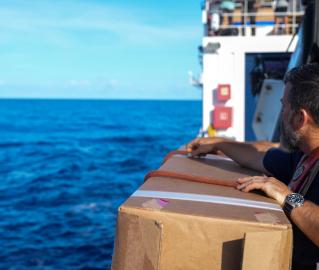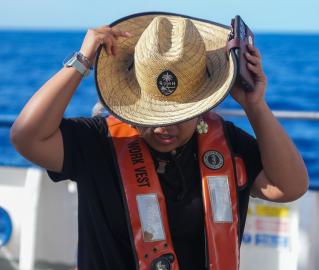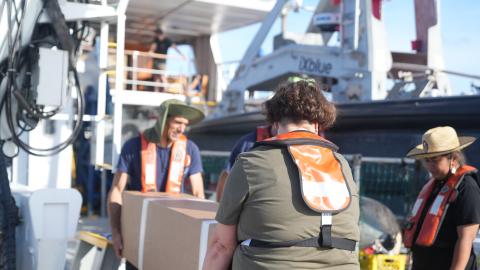Give it Everything You’ve Got: Science Communication at Sea
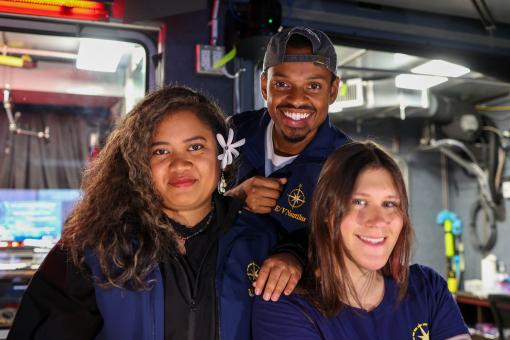
This blog was written by NA172 Communications Lead Marley Parker.
Hosting a live event from the Control Van is always invigorating. After congratulating my team on a job well done, I walk out onto the deck, lean against the railing, and breathe in the humid air of the equatorial Pacific. Gazing at the endless open ocean, I have the same thought I’ve had many, many times over the past few years:
I love my job.
When I tell people about my work – traveling to remote parts of the planet to document scientists and engineers conducting research in the middle of the ocean – the responses are often a mixture of surprise and awe, and usually, “that sounds like a dream job!”
While it is a dream job, it’s not a dream job that many people have heard of. When I was in college 15 years ago, I had no idea that being a globe-trotting science communicator (and producing stories about ocean expeditions) was an option.
Over the course of my career, I have met over 100 professional science communicators, but I don’t know a single person who had this thought when they were a child: when I grow up, I want to be a science communicator.
You can’t pursue a fulfilling career path if you don’t know it exists – that’s why events like the one we just hosted (see video below) are so important. It’s why I helped start a mentorship program for people who want to pursue science communication careers. It is also why the Science Communication Fellowship aboard E/V Nautilus is such a special opportunity.
During this most recent expedition aboard E/V Nautilus, I have had the privilege of working with three phenomenal Science Communication Fellows, all of whom are experienced educators, talented communicators, and fierce advocates for the natural world. In the three weeks we’ve spent together, I have learned so much from Emily Jones, Hassan Bayyan, and Shelterihna Alokoa.
Our conversations remind me there are a thousand different ways to become (and to be) a science communicator. We have discussed everything from turning points in our careers, to problematic social media content, to crazy travel experiences, to the questions people often ask about our work.
How do I get a job like yours? What degrees or certifications do you need to be a science communicator? What have you learned from doing this type of work?
Emily, Hassan, Shel, and I come from different backgrounds and have vastly different experiences – but we all firmly agree that you don’t need an advanced degree to be a successful science communicator.
Here’s what you do need:
Tenacity
A lover of the natural world since before he could walk, Hassan always knew he wanted to work with animals – but it took what he calls an “inordinate amount of effort” to get the experience he needed to land his dream job.
Shortly after high school, Hassan was hired in the Safari department of Six Flags Great Adventure in New Jersey.
“I was definitely underqualified for the position,” Hassan says. “But they gave me a shot. Getting a foot in the door was huge.”
To build a career as a zoologist and eventually move up into management positions, Hassan knew he would need to gain more professional experience in different places. He found a promising volunteer opportunity in Africa – but he had to pay his own way to get there.
“I pinched my pennies from working four different jobs and pulled together enough money to go to Zimbabwe,” Hassan says. “I did an internship at a wildlife orphanage called Chipangali – that’s when I knew this field was for me.”
After returning from Zimbabwe, Hassan bounced around, picking up valuable experience where he could – an education position at the Philadelphia Zoo, a coral restoration internship on the Great Barrier Reef, another internship at a wildlife preservation in Florida, and a management position at Odysea Aquarium – before finally landing a management position at the Maryland Zoo, where he currently works.
After a decade of hustling hard to get hands-on experience and prove himself, one might think Hassan would say I’ve made it. I achieved my goals.
But that’s not the type of person he is. Hassan’s innate desire to advocate for the natural world, coupled with his tenacious ambition, will always generate more opportunities. Now he wants to use the knowledge he’s gained to create compelling – yet non-harmful – educational content about animals.
“On social media, I’ve seen people harassing wildlife for clicks, likes, and views,” he says. “Steve Erwin had his time and place, but we know now that we shouldn’t be doing anything except taking pictures and leaving footprints.”
Just as he did 10 years ago, Hassan has outlined clear goals for the next phase of his career: diving deeper into filmmaking, connecting inner city people with nature and wildlife, and developing an audience of people who can differentiate “the real from the fugazy (false, bogus, inauthentic)”.
"In this world of misinformation, I want to empower people to think critically about the information they get from those who speak well and have nice smiles, but ultimately have no idea what they're talking about," Hassan says. “It’s one thing to memorize a bunch of facts – it’s a different thing entirely to hone your critical thinking. I want to provide the tools for people to do that.”
I have no doubt that he will.
Curiosity
From the island nation of the Federated States of Micronesia, Shelterihna Alokoa grew up in Guam, where her dad worked for the Guam EPA.
“From a young age, I was always aware of environmental issues from tagging along with my dad doing different local projects,” she says.
Shelterihna describes herself as an introvert, but that has never stopped her from asking questions and seeking out new opportunities. As a student at Pacific Islands University, she took every campus job she could get. While she was a full-time student, she worked with the audio-visual team, the library team, the cleaning crew, and the residential assistant program.
Shelterihna says each job gave her valuable experience and perspective. Working so many different jobs gave her the opportunity to learn from people who came from different backgrounds and taught her a broad range of skill sets.
“Whenever I want to learn something new, I’m not afraid to ask people. I’m not afraid to try new things,” she pauses before continuing. “Well, sometimes I’m afraid – but I force myself to do it anyway!”
That combination of curiosity and courage has served Shelterihna well throughout her career. From participating in citizen science projects to getting certified to scuba dive to applying for the Science Communication Fellowship on E/V Nautilus, she continuously pushes herself outside of her comfort zone.
Like Hassan, Shelterihna is setting goals for herself – she plans to complete her elementary education credential in order to continue to share ocean science and conservation with young learners.
“I want to create more regional knowledge lesson plans,” Shelterihna says. “Growing up, the public schools on Guam often didn’t teach students about what’s in our backyard. They taught U.S.A. based curriculum. I was taught to identify a red robin but not a Marianas Kingfisher.” She is driven to educate her community about the local beings that call the waters between the Marianas Island Archipelago home.
Vulnerability
When I ask Emily Jones about her childhood dreams and early ambitions, her response is immediate.
“I always wanted to be a teacher.”
Similar to Shelterihna’s desire to design more regionally relevant lessons, Emily cares deeply about creating educational activities that are meaningful and engaging.
“I hated school when I was kid, but I loved learning,” Emily says. “Some teachers made learning fun. I knew I wanted to do that too – to share my love of learning.”
To truly love the learning process, and to translate that love into effective teaching, Emily believes vulnerability is essential.
“In order to learn, you have to be vulnerable,” she says. “You have to recognize there are lots of things you don’t know – admit that. Get comfortable with that. And then seek out the answers.”
Getting comfortable with your own knowledge gaps also means being willing and able to learn from your mistakes. Emily tells me a story about when she first became an outdoor educator.
“I was teaching 10-year-olds about leaf shapes,” she says. “So I told everyone to go find a leaf.”
But she didn’t know that the area she and the kids were exploring was full of swamp milkweed – a plant that plays a critical role in the habitat of monarch butterflies.
“So the kids were plucking all these plant leaves that are vital for larval monarch survival.” Emily says. “I didn’t know that – I was deeply wrong, in a harmful way – and thought it was a tough lesson, it was a mistake that has taught me the importance of being thoughtful with my actions and words.”
She says she wouldn’t have learned the significance of this if she hadn’t tried something new and been wrong in the process.
Now, no matter where she is in the world, Emily goes out of her way to educate herself on local flora and fauna.
“I’m always aware of what plants are around me,” she says. “There are so many important plant relationships that we might harm if we don’t know about them.”
Emily takes the same approach for professional development and her growth as an individual. “You have to be comfortable with getting things wrong while you’re still learning,” she says.
“We don’t know where we need to grow if we’re not able to accept that there are skills we don’t yet have.”
Evolution
Ten years ago, when I was still new to the world of science communications, I used the following titles to describe my work: photographer, videographer, and writer. Those were the skills I learned in school – producing visual and written content was in my wheelhouse.
While I still regularly take photos, film videos, and write about research, the type of work I do and my skill sets have expanded in ways I never could have imagined a decade ago. Starting (and growing) a business, public speaking, teaching, mentoring, piloting drones, designing websites, leading workshops… the list keeps growing. Venturing beyond the familiar territory of my early career has been intimidating and uncomfortable at times, but it has also made all the difference.
As Hassan, Shelterihna, Emily (and many other folks in this field) have demonstrated, being a good science communicator is not about being comfortable. It’s about pushing yourself – to gain new knowledge, to learn complicated concepts, and to acquire new skills.
When it comes to carving out a career path in science communication, Hassan may have put it best.
“You’ve got to give it everything you’ve got,” he says, flashing his characteristic wide smile. “And then give it a little bit more!”
____________________________
If you would like to learn more about opportunities in science communication, education, and advocacy, check out some of the organizations that have been inspirational and instrumental in our careers:
The Association of Science Communicators | associationofsciencecommunicators.org
Black in Marine Science | blackinmarinescience.org
Chipangali Wildlife Orphanage | chipangali.com
White Oak Conservation | whiteoakwildlife.org
Teachers on the Estuary | coast.noaa.gov/estuaries/teachers-on-the-estuary
Dream Volunteers | dreamvolunteers.org
One Reef, Nicole Yamase onereef.org/team-member/nicole-yamase
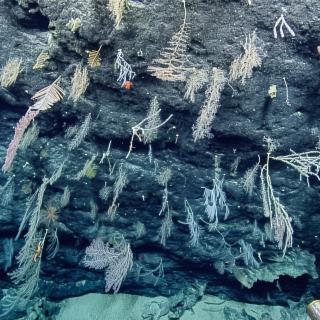
Exploring the Offshore Marianas
Update: Ongoing mechanical repair of a ship system has changed operational plans for the NA172 expedition, postponing the water column exploration and remotely operated vehicles portion of this expedition within the Mariana Trench Marine National Monument.

